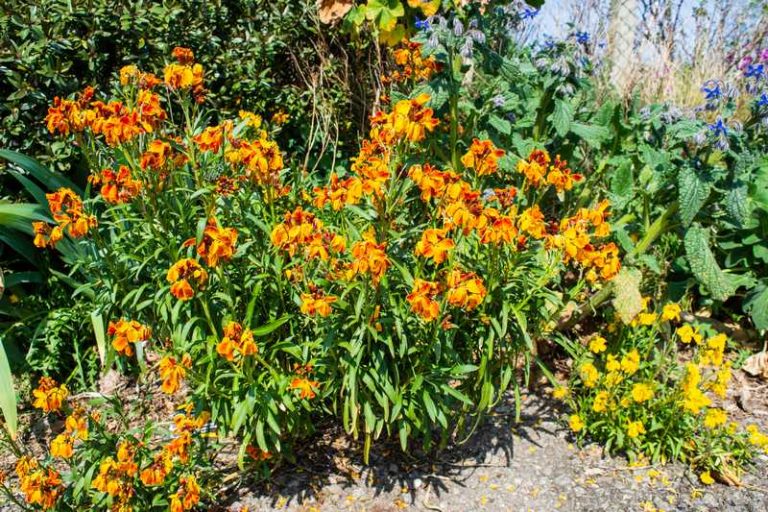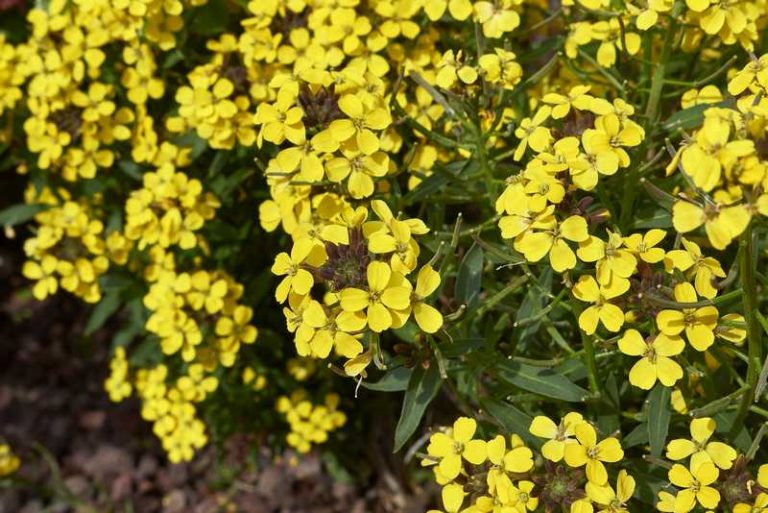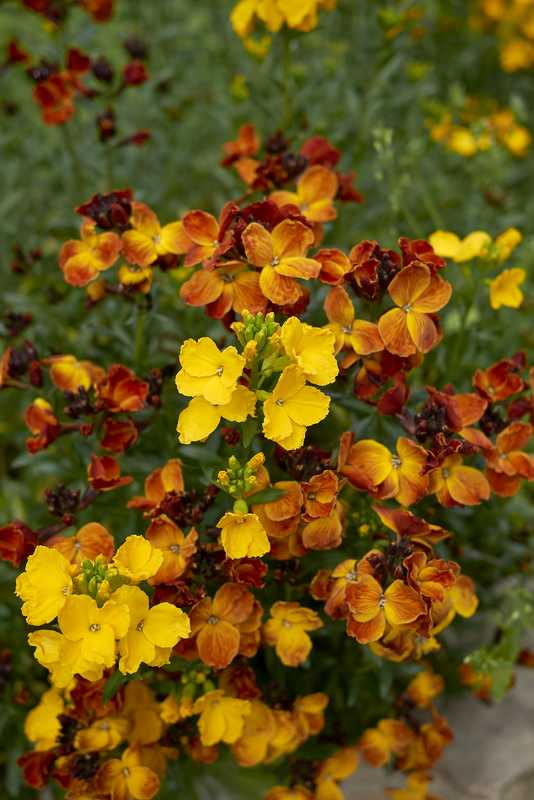
With their very colorful and fragrant flowers, wallflowers are a must in spring to garnish a sunny flower bed or for growing in pots. Although perennial, these plants are often grown as biennials.
What there is to know :
Botanical name: Cheiranthus cheiri, Erysimum cheiri
Common name : wallflower, wallflower, wallflower, spring wallflower
Type : Perennial, usually grown as a biennial
Family : Brassicaceae
Height x spread : 20cm to 40cm tall generally, with many dwarf varieties. (20cm). The upright stems are branched from the base
Foliage : Narrow, lanceolate leaves, dark green or silvery green
Flowering : From March to May. Arranged in clusters at the top of the stems, the single or double flowers are colored orange, yellow, red, pink, white or copper. Their 4 petals arranged in a cross are sometimes striated. These flowers bloom in mild climates from February to May. Very fragrant, they exhale spicy smells reminiscent of cloves, which earned them this name.
Exposure : In the sun
Soil : Any consistent drained soil, even dry, is suitable for it.
Hardiness : -10°C

When to plant wallflowers?
Sowing in terrine : Wallflower ravenelle is sown between the months of May and August in boxes filled with compost. Place your seedlings outdoors and in the shade. Germination takes place in a few days.
As soon as the first leaves appear, transplant the plants into individual pots to force the wallflower to produce many roots. Keep them in partial shade by watering them very regularly.
Sowing in a bucket : Direct sowing in a bucket is also possible. Put 2 or 3 seeds per cup, cover them with potting soil, tamp lightly with your fingers and water.
As soon as the first leaves appear, keep only the most beautiful plant in each pot.
Plant your wallflowers in the ground at the beginning of autumn , in October, 20 cm apart for the dwarf varieties and 35 cm for the tallest wallflowers.
Wallflowers naturally reseed themselves very easily, including on old walls, hence their nickname wallflowers .
Where to plant wallflowers?
Spring wallflowers are often grown as biennials. They are actually perennial plants that live for several years in the same place. For this, choose a sunny location. The soil must be perfectly drained. If your soil is heavy and sticky, mix sand and gravel before planting to improve drainage.
Wallflowers are excellent plants for flowerbeds and beds. You can plant them with tulip bulbs , narcissus, pansies, blue forget-me-nots or sweet carnations .
Dwarf varieties such as Tom Pouce make it possible to create carpets of flowers or very colorful borders. You can also use them to decorate a rockery in the company of baskets of gold, alyssum or aubrieta .
For a container culture, also choose a dwarf variety and make sure to offer them a rich and well-drained soil.

When should wallflowers be pruned?
During the fall, pinch the ends of the wallflowers to force them to branch out: this will give you more compact and flowery plants.
In the spring, regularly cut off faded flowers to encourage the appearance of new flower stalks.
After flowering, prune your tallest wallflowers to prevent the clump from taking on an unsightly habit.
Caring for wallflower
Watering : If it does not rain, keep the soil cool in spring during flowering by regular watering.
Should they be protected in winter? Some varieties of spring wallflowers are short-lived perennials. In mild climates, it is not useful to protect them from the cold if the soil is permeable. In harsher climates, protection against extreme cold is sometimes necessary to preserve them from one year to the next.
Diseases of Spring Wallflowers
Wallflowers are affected by classic diseases and parasites of the Brassicaceae family:
Cabbage clubroot : nodules are visible at the roots. The plants should be uprooted and no wallflowers or plants of the same family should be replanted in the same place for several years.
Mildew : the leaves have pale green spots on the top, gray below. Treat with Bordeaux mixture.
Gray rot, powdery mildew : the stems and flowers are covered with a gray powder. Also treat with Bordeaux mixture as a preventive measure.
Against insect pests : Flea beetles riddle the leaves of young seedlings with small holes and aphids gather in colonies on sap-soaked shoots. In order to fight against these insects, you can carry out treatments with black soap at 4 or 5 day intervals. Imported cabbageworm can also cause some damage during the summer.

Most common wallflower varieties
There are many perennial varieties. With age, the base of the stems becomes woody:
Erysimum Bowles mauve : a mauve wallflower . Shrubby and easy to grow, this popular variety offers beautiful mauve or purple flowers. Height: 70cm.
Erysimum Constant cheer : a dwarf but bushy variety with brick-red flowers, very fragrant and visited by many butterflies. Height: 30cm
Erysimum helveticum or rhoeticum , Swiss velar: a dwarf variety that forms a cushion of small dark green leaves and is covered with bright yellow flowers. This wallflower needs perfectly drained soil: install it between the stones of a rockery.
